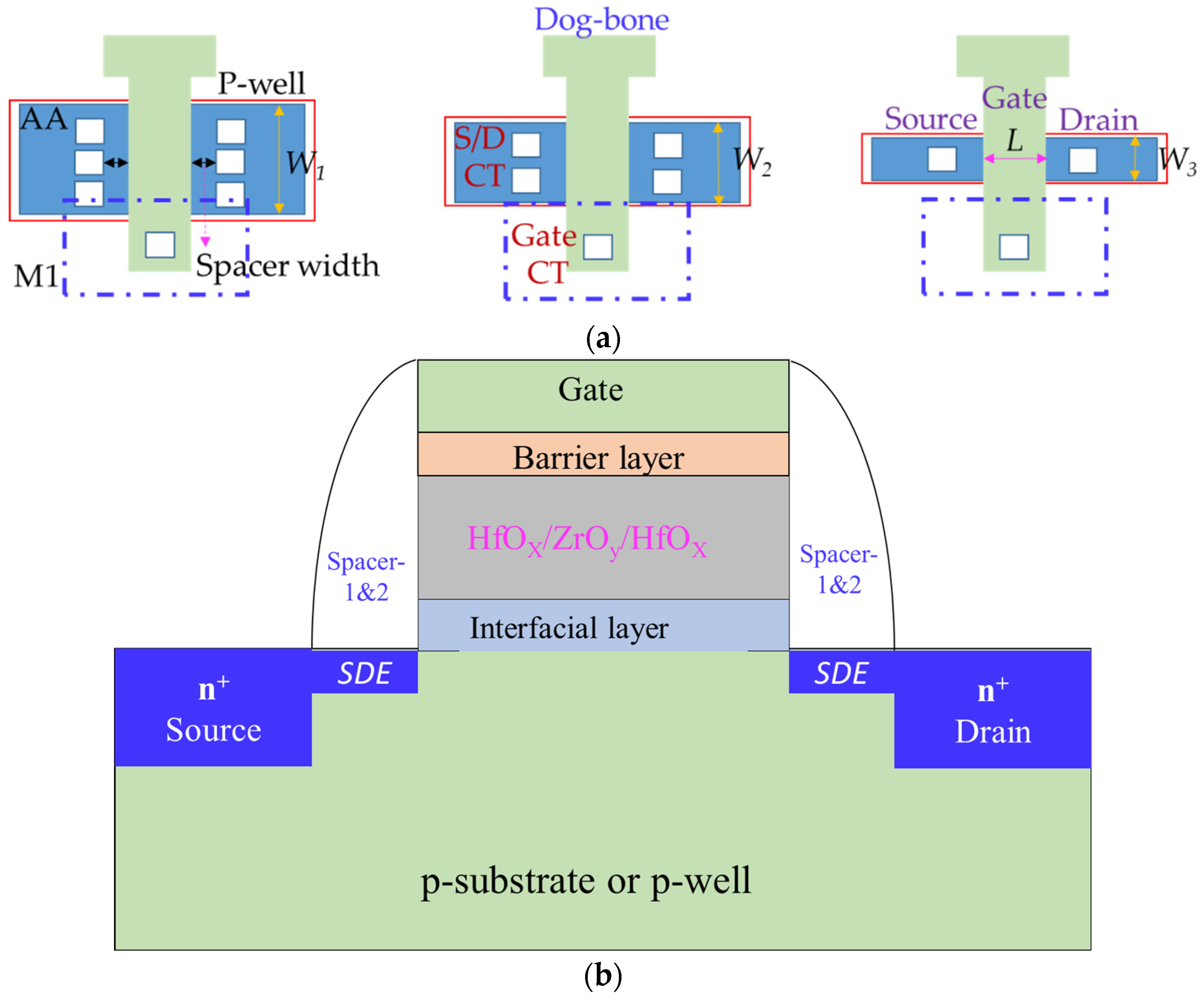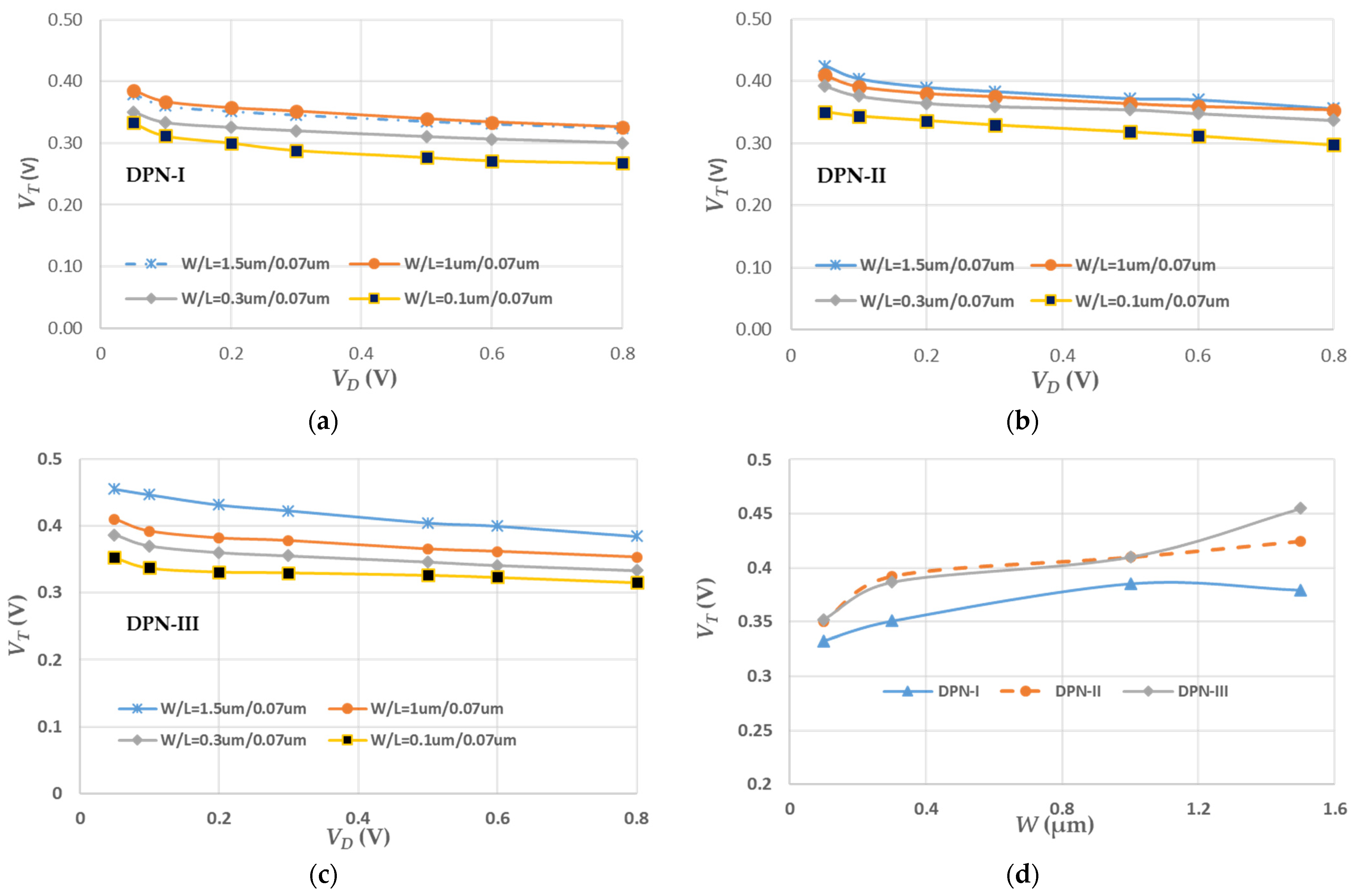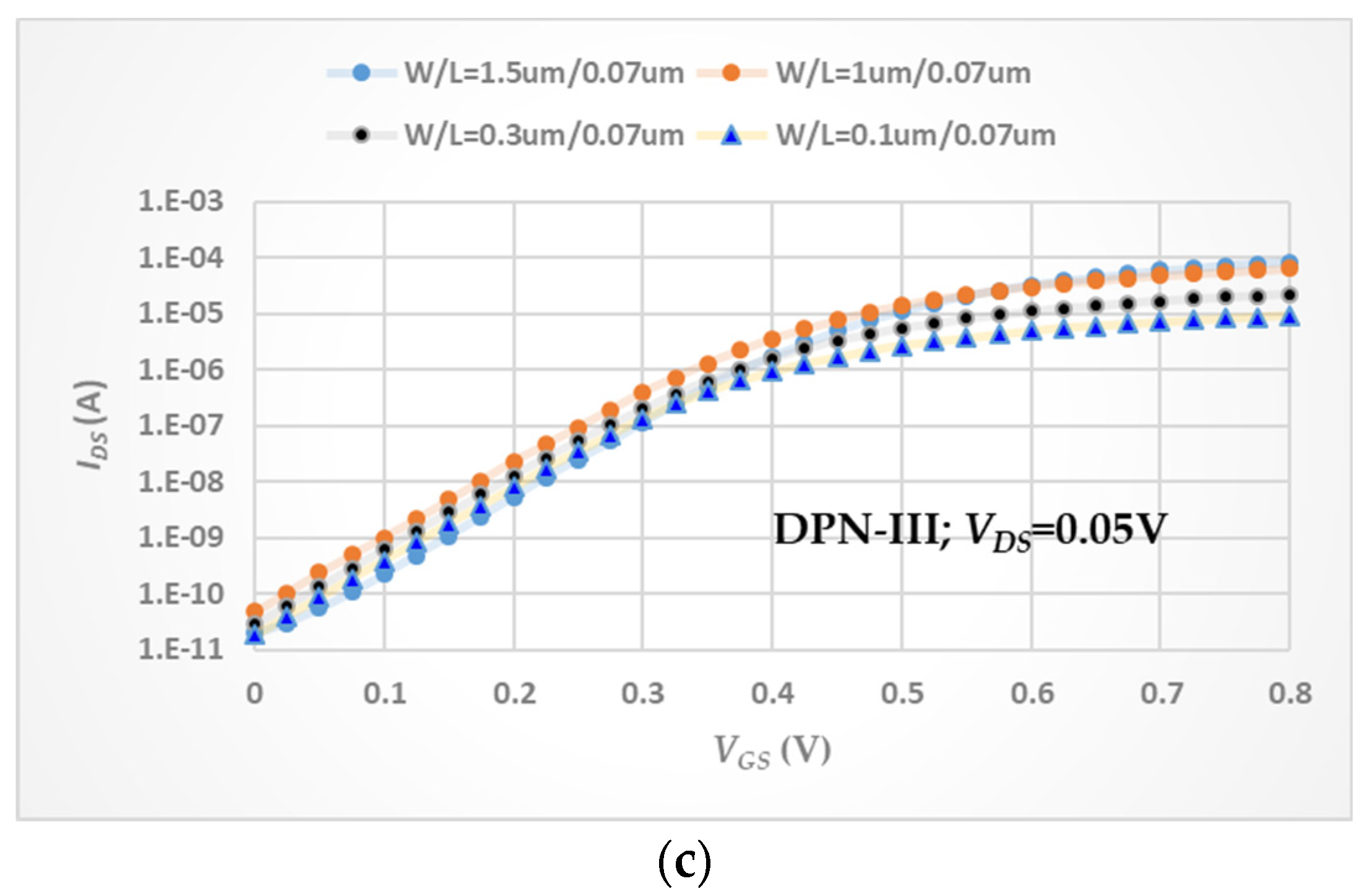Electrical Performance of 28 nm-Node Varying Channel-Width nMOSFETs under DPN Process Treatments
Abstract
:1. Introduction
2. Outline of Semiconductor Processes and Measurement Establishment
3. Results and Discussion
3.1. ION and IOFF Parameters
3.2. VT and Gm Performance
3.3. SS and DIBL Considerations
4. Conclusions
Author Contributions
Funding
Acknowledgments
Conflicts of Interest
References
- Ina, H.; Kasumi, K.; Kawakami, E.; Uda, K. Critical issues study of nano-imprint tool for semiconductor volume production. In Proceedings of the SPIE 6517, Emerging Lithographic Technologies XI, San Jose, CA, USA, 25 February–2 March 2007; Volume 6517. [Google Scholar] [CrossRef]
- New Way to Up Chip Yield from Semiconductor Wafer. Available online: https://scienceblog.com/528839/new-way-to-up-chip-yield-from-semiconductor-wafer (accessed on 12 July 2022).
- Unleashing the Future of Innovation. Available online: https://research.tsmc.com/assets/download/Chairman_2021_ISSCC.pdf (accessed on 22 June 2022).
- Moroz, V.; Huang, J.; Choi, M. FinFET/nanowire design for 5nm/3nm technology nodes: Channel cladding and introducing a “bottleneck” shape to remove performance bottleneck. In Proceedings of the IEEE Electron Devices Technology and Manufacturing Conference, Toyama, Japan, 28 February–2 March 2017. [Google Scholar] [CrossRef]
- New Transistor Structures at 3nm/2nm. Available online: https://semiengineering.com/new-transistor-structures-at-3nm-2nm// (accessed on 20 July 2022).
- Wang, M.; Hsieh, W.; Lin, C.; Chu, W.; Liao, W.; Lan, W. High-drain field impacting channel-length modulation effect for nano-node n-channel FinFETs. Crystals 2021, 11, 262. [Google Scholar] [CrossRef]
- Liaw, Y.; Liao, W.; Wang, M.; Lin, C.; Zhou, B.; Gu, H.; Li, D.; Zou, X. A high aspect ratio silicon-fin FinFET fabricated upon SOI wafer. Solid-State Electron. 2016, 126, 46–50. [Google Scholar] [CrossRef]
- Lee, J.C.; Cho, H.J.; Kang, C.S.; Rhee, S.; Kim, Y.H.; Choi, R.; Kang, C.Y.; Choi, C.; Abkar, M. High-k dielectrics and MOSFET characteristics. In Proceedings of the IEEE International Electron Devices Meeting, Washington, DC, USA, 8–10 December 2003. [Google Scholar] [CrossRef]
- Aditya, M.; Rao, K.S.; Sravani, K.G.; Guha, K. Simulation and drain current performance analysis of high-k gate dielectric FinFET. Silicon 2022, 14, 4075–4078. [Google Scholar] [CrossRef]
- Intel Introduces New RibbonFET and PowerVia Technologies. Available online: https://www.youtube.com/watch?v=Rt-7c9Wgnds/ (accessed on 20 July 2022).
- MBCFET—Multi-Bridge Channel FET. Available online: https://samsungatfirst.com/mbcfet/ (accessed on 12 June 2022).
- Seon, Y.; Chang, J.; Yoo, C.; Jeon, J. Device and circuit exploration of multi-nanosheet transistor for Sub-3 nm technology node. Electronics 2021, 10, 180. [Google Scholar] [CrossRef]
- Lee, K.-S.; Park, J.-Y. N-Type nanosheet FETs without ground plane region for process simplification. Micromachines 2022, 13, 432. [Google Scholar] [CrossRef]
- Chin, A.; Lin, B.C.; Chen, W.J.; Lin, Y.B.; Tsai, C. The effect of native oxide on thin gate oxide integrity. IEEE Electron Dev. Lett. 1988, 19, 426–428. [Google Scholar] [CrossRef] [Green Version]
- Chang, H.W.; Huang, P.K.; Yeh, J.W.; Davison, A.; Tsau, C.H.; Yang, C.C. Influence of substrate bias, deposition temperature and post-deposition annealing on the structure and properties of multi-principal-component (AlCrMoSiTi)N coatings. Surf. Coat. Technol. 2008, 202, 3360–3366. [Google Scholar] [CrossRef]
- Lim, S.W.; Luo, T.Y.; Jiang, J. Mechanism of silicon dioxide decoupled plasma nitridation. Jpn. J. Appl. Phys. 2006, 45, L413–L415. [Google Scholar] [CrossRef]
- Chen, C.-W.; Wang, S.-J.; Hsieh, W.-C.; Chen, J.-M.; Jong, T.; Lan, W.-H.; Wang, M.-C. Q-Factor performance of 28 nm-node high-k gate dielectric under DPN treatment at different annealing temperatures. Electronics 2020, 9, 2086. [Google Scholar] [CrossRef]
- Chao, S.-Y.; Huang, H.-S.; Huang, P.-R.; Lin, C.-Y.; Wang, M.-C. Channel mobility model of nano-node MOSFETs incorporating drain-and-gate electric fields. Crystals 2022, 12, 295. [Google Scholar] [CrossRef]
- Asif, R.M.; Rehman, S.U.; Rehman, A.U.; Bajaj, M.; Choudhury, S.; Dash, T.P. A Comparative Study of Short Channel Effects in 3-D FinFET with High-K Gate Di-electric. In Proceedings of the IEEE International Conference in Advances in Power, Signal, and Information Technology, Bhubaneswar, India, 8–10 October 2021. [Google Scholar] [CrossRef]
- Wang, S.J.; Wang, M.C.; Chen, S.Y.; Lan, W.H.; Yang, B.W.; Huang, L.S.; Liu, C.H. Heat stress exposing performance of deep-nano HK/MG nMOSFETs using DPN or PDA treatment. Microelectron. Reliab. 2015, 55, 2203–2207. [Google Scholar] [CrossRef]
- Xia, S.; Shi, Z.; Sun, L.; Sun, S.; Dastan, D.; Fan, R. Suppressing the loss and enhancing the breakdown strengths of high-k materials via constructing layered structure. Mater. Lett. 2022, 312, 131654–131657. [Google Scholar] [CrossRef]
- MacMillen, D.; Butts, M.; Camposano, R.; Hill, D.; Williams, T.W. An industrial view of electronic design automation. IEEE Trans. Comput.-Aided Des. Integr. Circuits Syst. 2000, 19, 1428–1448. [Google Scholar] [CrossRef] [Green Version]
- Xiao, H. Introduction to Semiconductor Manufacturing Technology, 2nd ed.; SPIE: Bellingham, DC, USA, 2012. [Google Scholar]
- Integrating High-k/Metal Gates: Gate-First or Gate-Last? Available online: https://sst.semiconductor-digest.com/2010/03/integrating-high-k/ (accessed on 12 June 2022).
- Wenger, C.; Lukosius, M.; Costina, I.; Sorge, R.; Dabrowski, J.; Müssig, H.J.; Pasko, S.; Lohe, C. Investigation of atomic vapour deposited TiN/HfO2/SiO2 gate stacks for MOSFET devices. Microelectron. Eng. 2008, 85, 1762–1765. [Google Scholar] [CrossRef]
- Dong, M.; Zhang, Y.; Hang, T.; Li, M. Structural effect of inhibitors on adsorption and desorption behaviors during copper electroplating for through-silicon vias. Electrochim. Acta 2021, 372, 137907. [Google Scholar] [CrossRef]
- Shie, K.-C.; Hsu, P.-N.; Li, Y.-J.; Tran, D.-P.; Chen, C. Failure Mechanisms of Cu–Cu Bumps under Thermal Cycling. Materials 2021, 14, 5522. [Google Scholar] [CrossRef]
- Kranti, A.; Armstrong, G.A. Source/Drain Extension Region Engineering in FinFETs for Low-Voltage Analog Applications. IEEE Electron Dev. Lett. 2007, 28, 139–141. [Google Scholar] [CrossRef]
- Jiang, L.; Wen, S.; Tai, W.; Lei, W.; Chang, L.; Cheng, Y. Device parameter variations of n-MOSFETS with dog-bone layouts in 65nm and 40nm technologies. In Proceedings of the IEEE 10th International Conference on ASIC, Shenzhen, China, 28–31 October 2013. [Google Scholar] [CrossRef]
- Hu, C. Modern Semiconductor Devices for Integrated Circuits, 1st ed.; Pearson: Hoboken, NJ, USA, 2010. [Google Scholar]
- Streetman, B.G.; Banerjee, S.K. Solid State Electronic Devices, 7th ed.; Pearson: Hoboken, NJ, USA, 2016. [Google Scholar]
- Bucher, M.; Makris, N.; Chevas, L. Generalized constant current method for determining MOSFET threshold voltage. IEEE Trans. Electron Dev. 2020, 67, 4559–4562. [Google Scholar] [CrossRef]
- Transconductance. Available online: https://en.wikipedia.org/wiki/Transconductance (accessed on 12 June 2022).
- Subthreshold Slope. Available online: https://en.wikipedia.org/wiki/Subthreshold_slope (accessed on 12 June 2022).
- Tsormpatzoglou, A.; Dimitriadis, C.A.; Clerc, R.; Pananakakis, G.; Ghibaudo, G. Threshold voltage model for short-channel undoped symmetrical double-gate MOSFETs. IEEE Trans. Electron Dev. 2008, 55, 2512–2516. [Google Scholar] [CrossRef]
- Hook, T.B.; Biesemans, S.; Slinkman, J. The dependence of channel length on channel width in narrow-channel CMOS devices for 0.35–0.13 μm technologies. IEEE Electron Dev. Lett. 2000, 21, 85–87. [Google Scholar] [CrossRef]
- Chen, X.; Ouyang, Q.; Wang, G.; Banerjee, S. Improved hot carrier and short channel performance in vertical nMOSFETs with graded channel doping. IBM Res. Rep. 2002, 49, 1962–1968. [Google Scholar]







| No. Wafer | SiO2 (IL) | HfOX/ZrOX/HfOX (Cycle) | Anneal | N2 |
|---|---|---|---|---|
| DPN-I | 9~12 Å | 10/4/10 | 700 °C | 8% |
| DPN-II | 9~12 Å | 10/4/10 | 900 °C | 8% |
| DPN-III | 9~12 Å | 10/4/10 | 700 °C | 16% |
| Parameter Extraction | Sensing Metrology |
|---|---|
| VT | Sensing IDS − VGS as fixed VDS = 50 mV. Extracting the VT value as the expected IDS (nA) = 100 × W/L. |
| ION | Measuring IDS − VDS as fixed VGS = VDD or (VGS−VT) = VDD. Choosing IDS as VDS = VDD. |
| IOFF | Sensing IDS − VDS as VG = VS = VB = 0 V. Recording ID, IG, IS, and IB as VDS = VDD. |
| Gm | Deriving IDS − VGS as fixed VDS = 50 mV. Extracting the maximum Gm_max. |
| SS | Deriving Log(IDS) − VGS as fixed VDS = 50 mV or VDD. Extracting the slope and taking the reciprocal. |
| Tested Device W/L (μm/μm) | DPN-I | DPN-II | DPN-III |
|---|---|---|---|
| 1.5/0.07 | 77.5 | 75.4 | 81.6 |
| 1/0.07 | 61.5 | 52.2 | 38.4 |
| 0.3/0.07 | 25.7 | 17.9 | 17.6 |
| 0.1/0.07 | 11.7 | 8.37 | 7.17 |
| Tested Device W/L (μm/μm) | DPN-I | DPN-II | DPN-III |
|---|---|---|---|
| 1.5/0.07 | 602 | 721 | 311 |
| 1/0.07 | 67.7 | 103 | 98.6 |
| 0.3/0.07 | 123 | 119 | 80.8 |
| 0.1/0.07 | 18 | 236 | 45.1 |
| Tested Device W/L (μm/μm) | DPN-I | DPN-II | DPN-III |
|---|---|---|---|
| 1.5/0.07 | 0.380 | 0.425 | 0.455 |
| 1/0.07 | 0.386 | 0.410 | 0.410 |
| 0.3/0.07 | 0.351 | 0.392 | 0.387 |
| 0.1/0.07 | 0.333 | 0.350 | 0.352 |
| 1.5/0.09 | 0.368 | 0.362 | 0.396 |
| Tested Device W/L (μm/μm) | DPN-I | DPN-II | DPN-III | DPN-I Normalization | DPN-II Normalization | DPN-III Normalization |
|---|---|---|---|---|---|---|
| 1.5/0.07 | 190 | 274 | 267 | 127 | 183 | 178 |
| 1/0.07 | 149 | 175 | 179 | 149 | 175 | 179 |
| 0.3/0.07 | 52.3 | 53.1 | 59.2 | 174 | 177 | 197 |
| 0.1/0.07 | 22.0 | 20.8 | 23.2 | 220 | 208 | 232 |
| 1.5/0.09 | 204 | 235 | 123 | 175 | 202 | 105 |
| Tested Device W/L (μm/μm) | DPN-I | DPN-II | DPN-III |
|---|---|---|---|
| 1.5/0.07 | 85.4 | 81.5 | 74.5 |
| 1/0.07 | 84.8 | 74.9 | 81.8 |
| 0.3/0.07 | 83.9 | 78.9 | 82 |
| 0.1/0.07 | 83 | 82.4 | 79.7 |
| 1.5/0.09 | 84.9 | 83.5 | 80.6 |
| Tested Device W/L (μm/μm) | DPN-I | DPN-II | DPN-III |
|---|---|---|---|
| 1.5/0.07 | 74.1 | 92.1 | 94.4 |
| 1/0.07 | 79.7 | 75.5 | 76.1 |
| 0.3/0.07 | 67.5 | 73.2 | 71.2 |
| 0.1/0.07 | 87.3 | 70.0 | 49.6 |
Publisher’s Note: MDPI stays neutral with regard to jurisdictional claims in published maps and institutional affiliations. |
© 2022 by the authors. Licensee MDPI, Basel, Switzerland. This article is an open access article distributed under the terms and conditions of the Creative Commons Attribution (CC BY) license (https://creativecommons.org/licenses/by/4.0/).
Share and Cite
Chao, S.-Y.; Lan, W.-H.; Fan, S.-K.; Zhon, Z.-W.; Wang, M.-C. Electrical Performance of 28 nm-Node Varying Channel-Width nMOSFETs under DPN Process Treatments. Micromachines 2022, 13, 1861. https://doi.org/10.3390/mi13111861
Chao S-Y, Lan W-H, Fan S-K, Zhon Z-W, Wang M-C. Electrical Performance of 28 nm-Node Varying Channel-Width nMOSFETs under DPN Process Treatments. Micromachines. 2022; 13(11):1861. https://doi.org/10.3390/mi13111861
Chicago/Turabian StyleChao, Shou-Yen, Wen-How Lan, Shou-Kong Fan, Zi-Wen Zhon, and Mu-Chun Wang. 2022. "Electrical Performance of 28 nm-Node Varying Channel-Width nMOSFETs under DPN Process Treatments" Micromachines 13, no. 11: 1861. https://doi.org/10.3390/mi13111861






